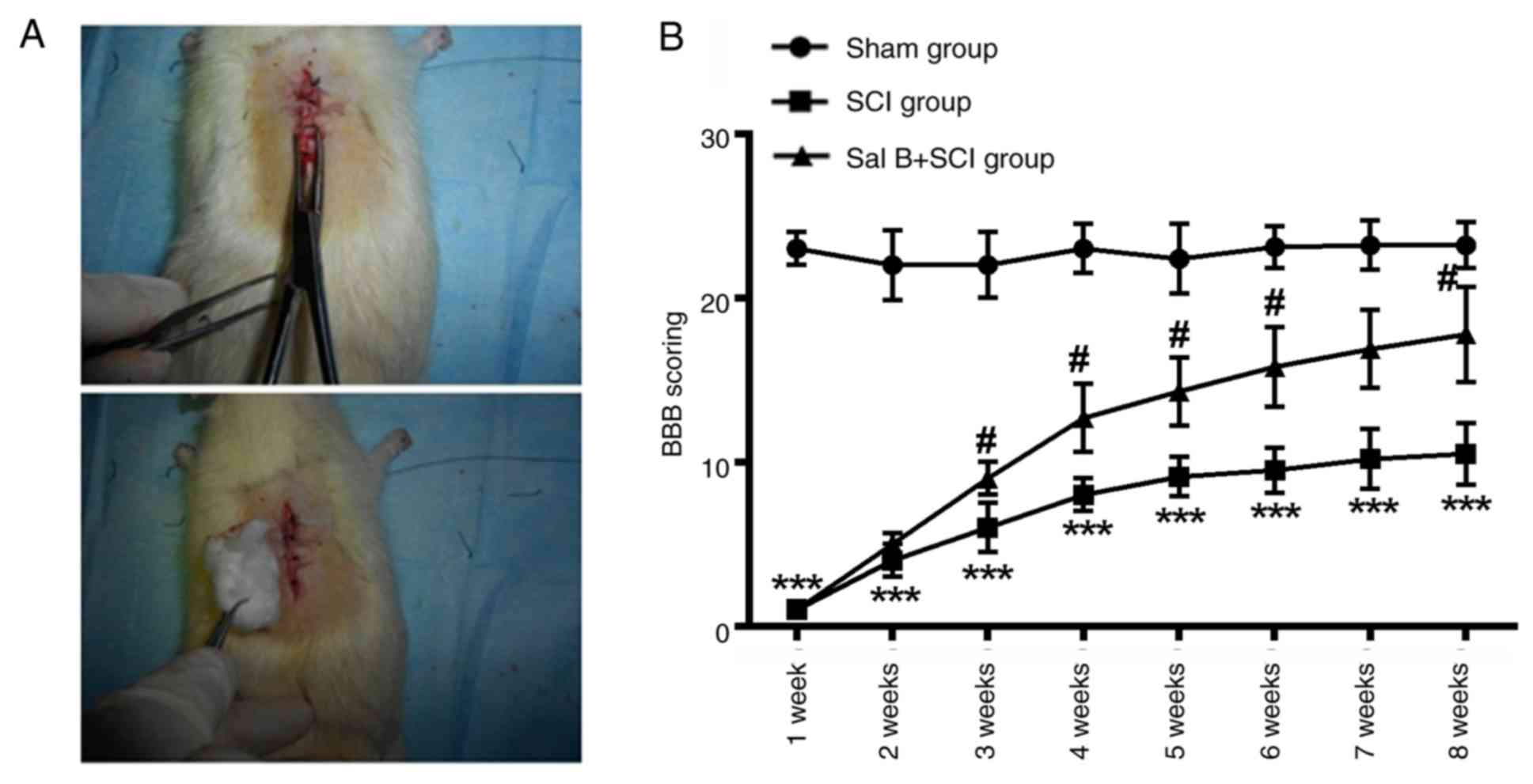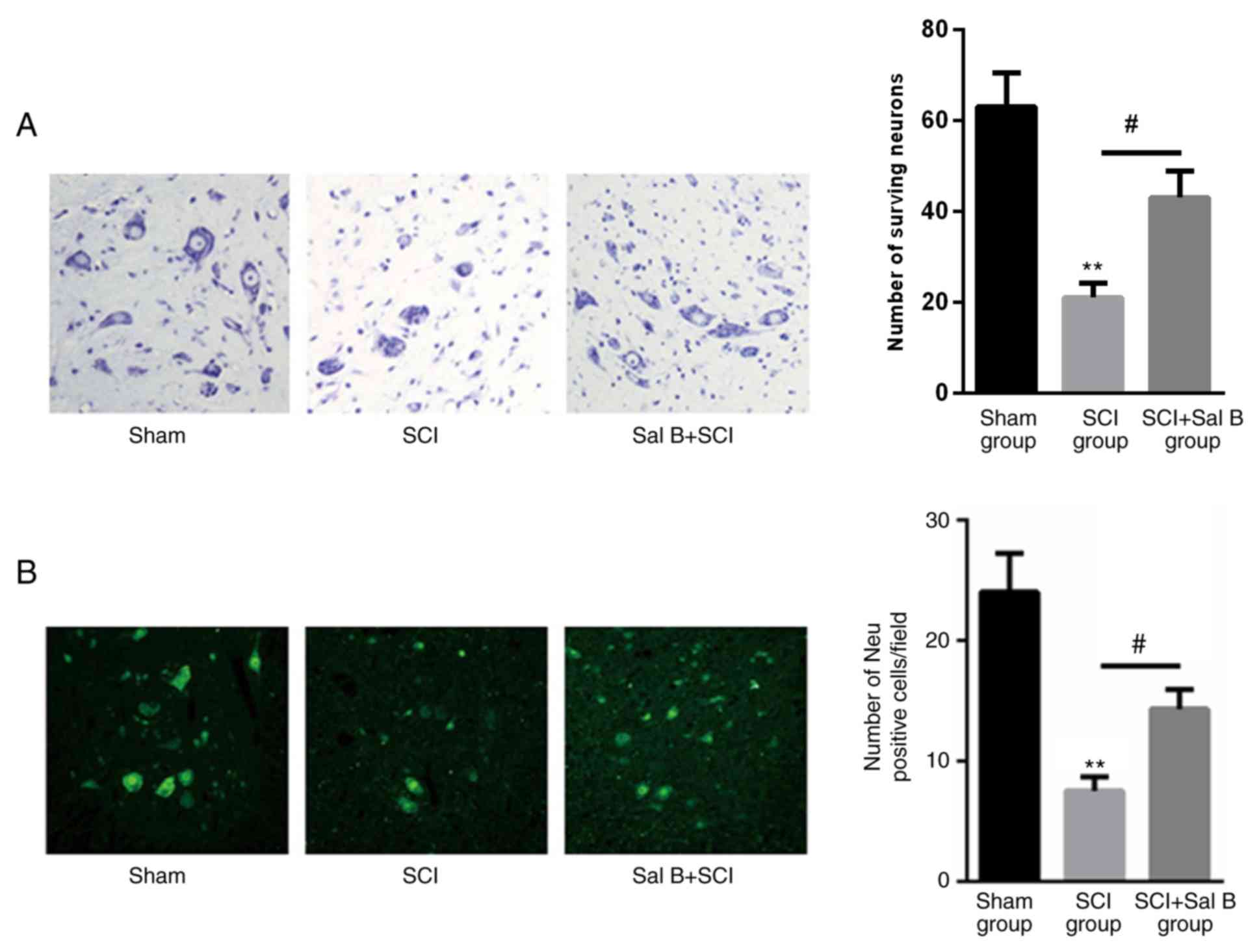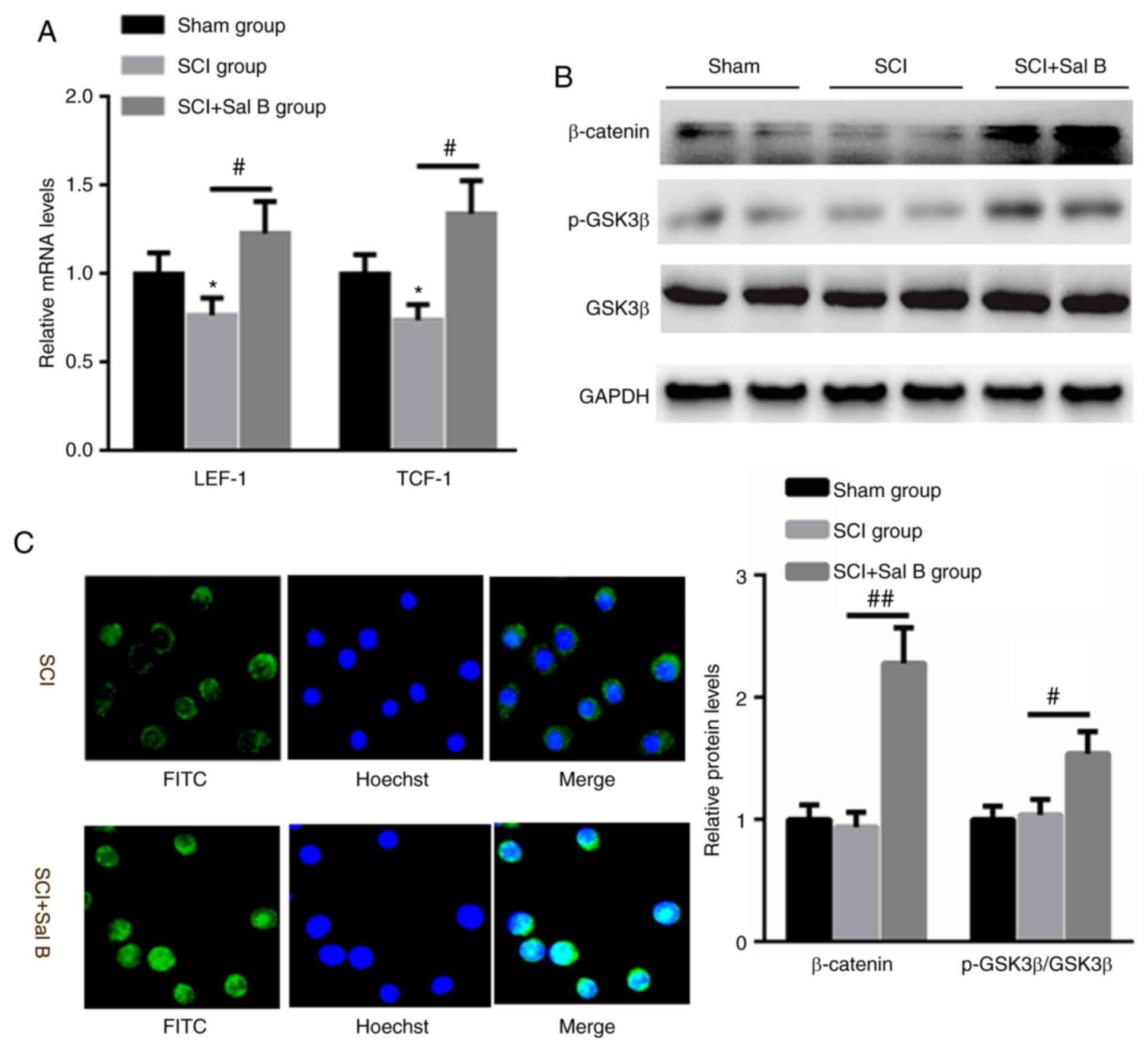|
1
|
Shen Z, Zhou Z, Gao S, Guo Y, Gao K, Wang
H and Dang X: Melatonin inhibits neural cell apoptosis and promotes
locomotor recovery via activation of the Wnt/β-catenin signaling
pathway after spinal cord injury. Neurochem Res. 42:2336–2343.
2017. View Article : Google Scholar : PubMed/NCBI
|
|
2
|
Xu K, Chen QX, Li FC, Chen WS, Lin M and
Wu QH: Spinal cord decompression reduces rat neural cell apoptosis
secondary to spinal cord injury. J Zhejiang Univ Sci B. 10:180–187.
2009. View Article : Google Scholar : PubMed/NCBI
|
|
3
|
Zhou Z, Chen S, Zhao H, Wang C, Gao K, Guo
Y, Shen Z, Wang Y, Wang H and Mei X: Probucol inhibits neural cell
apoptosis via inhibition of mTOR signaling pathway after spinal
cord injury. Neuroscience. 329:193–200. 2016. View Article : Google Scholar : PubMed/NCBI
|
|
4
|
Gao K, Shen Z, Yuan Y, Han D, Song C, Guo
Y and Mei X: Simvastatin inhibits neural cell apoptosis and
promotes locomotor recovery via activation of Wnt/β-catenin
signaling pathway after spinal cord injury. J Neurochem.
138:139–149. 2016. View Article : Google Scholar : PubMed/NCBI
|
|
5
|
Yamagami T, Pleasure DE, Lam KS and Zhou
CJ: Transient activation of Wnt/β-catenin signaling reporter in
fibrotic scar formation after compression spinal cord injury in
adult mice. Biochem Biophys Res Commun. 496:1302–1307. 2018.
View Article : Google Scholar : PubMed/NCBI
|
|
6
|
Herman PE, Papatheodorou A, Bryant SA,
Waterbury CKM, Herdy JR, Arcese AA, Buxbaum JD, Smith JJ, Morgan JR
and Bloom O: Highly conserved molecular pathways, including Wnt
signaling, promote functional recovery from spinal cord injury in
lampreys. Sci Rep. 8:7422018. View Article : Google Scholar : PubMed/NCBI
|
|
7
|
Hsu HC, Liu YS, Tseng KC, Tan BC, Chen SJ
and Chen HC: LGR5 regulates survival through mitochondria-mediated
apoptosis and by targeting the Wnt/β-catenin signaling pathway in
colorectal cancer cells. Cell Signal. 26:2333–2342. 2014.
View Article : Google Scholar : PubMed/NCBI
|
|
8
|
Li B, Zeng M, He W, Huang X, Luo L, Zhang
H and Deng DY: Ghrelin protects alveolar macrophages against
lipopolysaccharide-induced apoptosis through growth hormone
secretagogue receptor 1a-dependent c-Jun N-terminal kinase and
Wnt/beta-catenin signaling and suppresses lung inflammation.
Endocrinology. 156:203–217. 2015. View Article : Google Scholar : PubMed/NCBI
|
|
9
|
Libro R, Giacoppo S, Bramanti P and Mazzon
E: Is the Wnt/β-catenin pathway involved in the anti-inflammatory
activity of glucocorticoids in spinal cord injury? Neuroreport.
27:1086–1094. 2016. View Article : Google Scholar : PubMed/NCBI
|
|
10
|
Fu J, Fan HB, Guo Z, Wang Z, Li XD, Li J
and Pei GX: Salvianolic acid B attenuates spinal cord
ischemia-reperfusion-induced neuronal injury and oxidative stress
by activating the extracellular signal-regulated kinase pathway in
rats. J Surg Res. 188:222–230. 2014. View Article : Google Scholar : PubMed/NCBI
|
|
11
|
Fan ZK, Lv G, Wang YF, Li G, Yu DS, Wang
YS, Zhang YQ, Mei XF and Cao Y: The protective effect of
salvianolic acid B on blood-spinal cord barrier after compression
spinal cord injury in rats. J Mol Neurosci. 51:986–993. 2013.
View Article : Google Scholar : PubMed/NCBI
|
|
12
|
Zhu Z, Ding L, Qiu WF, Wu HF and Li R:
Salvianolic acid B protects the myelin sheath around injured spinal
cord axons. Neural Regen Res. 11:487–492. 2016. View Article : Google Scholar : PubMed/NCBI
|
|
13
|
Bi XB, Deng YB, Gan DH and Wang YZ:
Salvianolic acid B promotes survival of transplanted mesenchymal
stem cells in spinal cord-injured rats. Acta Pharmacol Sin.
29:169–176. 2008. View Article : Google Scholar : PubMed/NCBI
|
|
14
|
Chen H, Li J, Liang S, Lin B, Peng Q, Zhao
P, Cui J and Rao Y: Effect of hypoxia-inducible factor-1/vascular
endothelial growth factor signaling pathway on spinal cord injury
in rats. Exp Ther Med. 13:861–866. 2017. View Article : Google Scholar : PubMed/NCBI
|
|
15
|
Vachon P, Faubert S, Blais D, Comtois A
and Bienvenu JG: A pathophysiological study of abdominal organs
following intraperitoneal injections of chloral hydrate in rats:
Comparison between two anaesthesia protocols. Lab Anim. 34:84–90.
2000. View Article : Google Scholar : PubMed/NCBI
|
|
16
|
Guo J, Li M, Meng X, Sui J, Dou L, Tang W,
Huang X, Man Y, Wang S and Li J: MiR-291b-3p induces apoptosis in
liver cell line NCTC1469 by reducing the level of RNA-binding
protein HuR. Cell Physiol Biochem. 33:810–822. 2014. View Article : Google Scholar : PubMed/NCBI
|
|
17
|
Livak KJ and Schmittgen TD: Analysis of
relative gene expression data using real-time quantitative PCR and
the 2(-Delta Delta C(T)) method. Methods. 25:402–408. 2001.
View Article : Google Scholar : PubMed/NCBI
|
|
18
|
Li S and Wang J: Salvianolic acid B
prevents steroid-induced osteonecrosis of the femoral head via
PPARg expression in rats. Exp Ther Med. 13:651–656. 2017.
View Article : Google Scholar : PubMed/NCBI
|
|
19
|
Lou Y, Wang C, Zheng W, Tang Q, Chen Y,
Zhang X, Guo X and Wang J: Salvianolic acid B inhibits
IL-1β-induced inflammatory cytokine production in human
osteoarthritis chondrocytes and has a protective effect in a mouse
osteoarthritis model. Int Immunopharmacol. 46:31–37. 2017.
View Article : Google Scholar : PubMed/NCBI
|
|
20
|
Lu GB, Niu FW, Zhang YC, Du L, Liang ZY,
Gao Y, Yan TZ, Nie ZK and Gao K: Methylprednisolone promotes
recovery of neurological function after spinal cord injury:
Association with Wnt/β-catenin signaling pathway activation. Neural
Regen Res. 11:1816–1823. 2016. View Article : Google Scholar : PubMed/NCBI
|
|
21
|
Miyashita T, Koda M, Kitajo K, Yamazaki M,
Takahashi K, Kikuchi A and Yamashita T: Wnt-Ryk signaling mediates
axon growth inhibition and limits functional recovery after spinal
cord injury. J Neurotrauma. 26:955–964. 2009. View Article : Google Scholar : PubMed/NCBI
|
|
22
|
Strand NS, Hoi KK, Phan TMT, Ray CA,
Berndt JD and Moon RT: Wnt/β-catenin signaling promotes
regeneration after adult zebrafish spinal cord injury. Biochem
Biophys Res Commun. 477:952–956. 2016. View Article : Google Scholar : PubMed/NCBI
|
|
23
|
Briona LK, Poulain FE, Mosimann C and
Dorsky RI: Wnt/β-catenin signaling is required for radial glial
neurogenesis following spinal cord injury. Dev Biol. 403:15–21.
2015. View Article : Google Scholar : PubMed/NCBI
|
|
24
|
Gifre L, Vidal J, Carrasco JL, Filella X,
Ruiz-Gaspà S, Muxi A, Portell E, Monegal A, Guañabens N and Peris
P: Effect of recent spinal cord injury on wnt signaling antagonists
(sclerostin and dkk-1) and their relationship with bone loss. A
12-month prospective study. J Bone Miner Res. 30:1014–1021. 2015.
View Article : Google Scholar : PubMed/NCBI
|
|
25
|
Jiang SD, Yan J, Jiang LS and Dai LY:
Down-regulation of the Wnt, estrogen receptor, insulin-like growth
factor-I, and bone morphogenetic protein pathways in osteoblasts
from rats with chronic spinal cord injury. Joint Bone Spine.
78:488–492. 2011. View Article : Google Scholar : PubMed/NCBI
|
|
26
|
Fu H, Li F, Thomas S and Yang Z:
Hyperbaric oxygenation alleviates chronic constriction injury
(CCI)-induced neuropathic pain and inhibits GABAergic neuron
apoptosis in the spinal cord. Scand J Pain. 17:330–338. 2017.
View Article : Google Scholar : PubMed/NCBI
|
|
27
|
Wang XJ, Kong KM, Qi WL, Ye WL and Song
PS: Interleukin-1 beta induction of neuron apoptosis depends on p38
mitogen-activated protein kinase activity after spinal cord injury.
Acta Pharmacol Sin. 26:934–942. 2005. View Article : Google Scholar : PubMed/NCBI
|


















